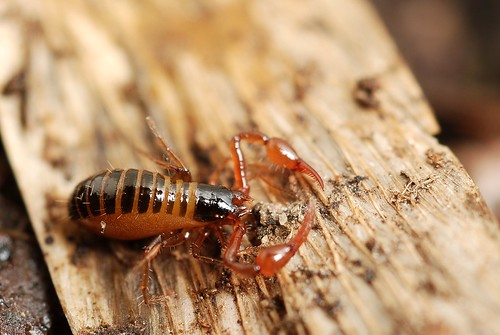-Garfman
There are over a hundred thousand named Arachnids crawling around on our planet's surface, and America is more aware of them this time of year than any other season. Famous though they are, these ubiquitous terrestrial predators are seldom evaluated for their conservation status, and the exceptions have consisted almost entirely of spiders - really only one of several strange and incredibly ancient Arachnid groups.
 | ||
| Image by Gilles San Martin |
Currently, there are at least two non-spider Arachnida recognized as threatened, and both of them belong to the family Lycosidae, or "pseudoscorpions." Though found virtually everywhere, these mostly blind predators go largely unnoticed due to their subterranean habits and incredibly small size - so small you can find them preying upon mites, lice and springtails between grains of soil, under the wing cases of beetles, in the fur of mice or between the pages of dusty, moldy old books. Many species will even use far larger, flying insects as transportation, grabbing into their leg hairs with a single claw and letting go at the next landing.
As their names imply, pseudoscorpions are entirely separate from the true scorpions, lacking the venomous tails but bearing very similar pincers which, in many species, can inject venom through the lower thumb-like claw. As an added bonus, they can also regurgitate a corrosive enzyme over stunned prey and secrete silk from their jaws, usually used to build igloo-shaped cocoons in which they molt and overwinter. Mating typically involves a "dancing" ritual where the male, locking pincers with the female, guides her over a sperm packet he lays on the ground. Like many other arachnids, females will carry their babies on their backs until tough enough to fend for themselves.
These minute animals have existed in more or less the same form for over 380 million years, but at least two species could disappear on us at any moment. Known endangered Lycosids include Fissilicreagris imperialis and Tartarocreagris texana, the Empire cave and Tooth Cave pseudoscorpions. Like many other creatures you can read about on EUT, these troglobytes are completely unique to their respective cave systems and have adapted to survive in no other environment. Any unusual activity can be disastrous for cave dwelling organisms; even a few careless spelunkers or a trickle of urban runoff can disrupt conditions that have remained unchanged for eons.
A staggering portion of the human race suffers from unreasonable levels of terror associated with eight-legged arthropods, but it's not fair to let a widespread phobia cloud our concern for the plight of any species, large or small. If more of us could get past our fears and appreciate just how weird, cool and useful the Arachnids are, we might be seeing quite a few more of them not only listed, but actively protected. Right now, eyeless micromonsters are dancing in each other's arms in pitch darkness, and surely deserve as much as any other animal to continue doing so for ages to come.

2 comments:
What a beautiful description~
Sorry to correct you but Lycosidae is actually a family of spiders (more commonly known as wolf spiders) while pseudoscorpions is an order within the class Arachnida.
That being said it's true that pseudoscorpions are fascinating and yet poorly studied creatures.
Post a Comment